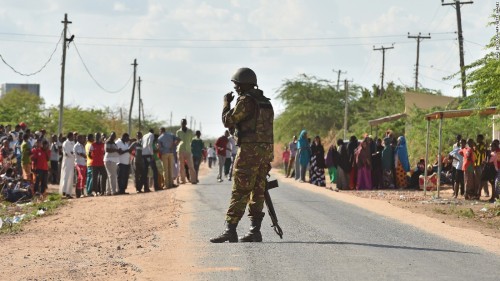
BRIEFS
BRIEFS
GARISSA UNIVERSITY ATTACKS HIGHLIGHT AL-SHABAAB’S RESILIENCY
Kathryn Basinsky
The Garissa University attacks have demonstrated al-Shabaab’s resiliency despite growing evidence that international efforts against al-Shabaab have been paying off. In the past year, the group lost a significant amount of territory in Somalia, and a number of senior leaders were killed; the most recent of whom, Adan Garaar, the alleged ringleader of the September 2013 Westgate Mall attack in Kenya, was killed in a U.S. drone strike on March 13 in southern Somalia (The Standard [Nairobi], March 12). In addition, there have been a series of defections within the group, and Kenyan security forces disrupted a recruiting network in that country. The militant group is still a force to be reckoned with, however. The siege of Garissa University in Kenya on April 2 continued a trend of high-profile and deadly attacks within Kenya, and on Kenya Christians in particular, indicating that as safe havens in Somalia have been eliminated, the group is shifting their focus to soft targets, as evidenced by the Westgate attack, and territories.
Al-Shabaab has increasingly focused their attacks within Kenya. The April 2 attack on Garissa University College, in which militants laid siege to the college campus for hours until their defeat by security forces, is the latest example. An estimated 147 people were killed, making this the deadliest al-Shabaab attack yet (Reuters, April 2). Earlier this year, al-Shabaab launchers a cross-border raid from Somalia when they locked several people inside a shop and set it on fire, killing at least four (Horseed Media, March 18). This raid occurred in Wajir, roughly 100 kilometers (60 miles) from the Somali-Kenyan border. The ability of militants to cross this far into Kenya comes as the country considers building a security wall along its border with Somalia in order to halt these types of cross-border incursions (The Standard, March 23). In another notable development, which underlines the group’s continuing attraction to some Islamist radicals, multiple Kenyan women have been arrested at the border for trying to marry al-Shabaab militants (The Standard [Nairobi], March 31). The latest three women arrested were well-educated and from middle-class families, upending the narrative that the Kenyans who join the group are poorer and uneducated. The arrests also provide a clear point of comparison with women joining the Islamic State in Syria and Iraq, who are often from similar related privileged backgrounds.
Meanwhile, in Uganda, Joan Kagezi, the lead prosecutor in the ongoing trial of 13 men accused of terrorism, murder and membership in a terrorist organization, was killed on March 30 by two men who shot her while she was commuting home from work (The Standard [Nairobi], March 31). This comes shortly after the U.S. Embassy in Kampala warned of a potential terrorist attack. The 13 accused are on trial in connection with the 2010 World Cup bombings in Kampala, al-Shabaab’s first major attack outside of Somalia. 74 people were killed in these attacks when suicide bombers detonated at viewing parties at an Ethiopian restaurant and a rugby club during the final match (al-Jazeera, July 13, 2010).
In Somalia, itself, al-Shabaab’s fortunes have been mixed. On March 27, al-Shabaab attacked the Maka al-Mukarramah Hotel in Mogadishu, first with a suicide vehicle borne improvised explosive device (VBIED), which was followed by additional militants storming the building. Eighteen people were killed, including Yusuf Mohamed Ismail (a.k.a. Bari-Bari), Somalia’s ambassador to Switzerland and Permanent Representative to the UN in Geneva (AllAfrica, March 30). Some of those killed were initially taken as hostages, but were then beheaded (Garowe Online, March 28). This additional level of brutality is strongly reminiscent of the Islamic State’s approach to killing hostages in Syria and Iraq. In contrast to this display of power in the heart of the capital, however, two days later, a key al-Shabaab member, Mohamed Ali Hassan, surrendered to Somalia government troops in Bakool, in southwestern Somalia. Hassan was a key member of al-Shabaab’s highly effective intelligence wing, Amniyat, and was responsible for a number of suicide bombings (Garowe Online, March 30). His defection will certainly reduce al-Shabaab’s operational capacity in Bakool both as a result of the group losing his expertise and in terms of intelligence that he reveals to the Somali government.
These developments indicate that, despite the loss of a substantial amount of territory and the deaths of key leaders, al-Shabaab is still capable of conducting deadly attacks across the Horn of Africa region. Indeed, the group has proven itself able to bounce back before, having alternated between controlling substantial amounts of Somalia and controlling very little territory since the fall of the Islamic Courts Union, its predecessor, in 2006 (Terrorism Monitor, January 23). Assassinations and suicide attacks are likely to be al-Shabaab’s lifeline until the group is either eliminated or retakes territory.
INDONESIAN ARRESTS UNDERLINE INFLUENCE OF ISLAMIC STATE
James Brandon
A series of arrests of Indonesians, both in Indonesia and abroad, during the last month have thrown fresh light on the Islamic State’s influence over the country’s small community of radicals. On March 21, Indonesian security forces arrested six individuals in the Kebayoran Baru, Bekasi and South Tangerang areas of the capital Jakarta, on suspicion of involvement in recruiting individuals to the Islamic State (Jakarta Globe, March 22). A few days later, on March 25, three Islamic State veterans were arrested in Malang in East Java. The authorities said that they had associated in Syria with Abu Jandal al-Indonesia, an prominent Indonesian Islamic State member who recently issued threats against the country’s military in a Bahasa-language YouTube video (Jakarta Post, March 27). Although investigations are ongoing, at least one of the arrested men had reportedly claimed that he left the Islamic State after it didn’t deliver on various promises given to him by recruiters. While related details are sparse, this may reflect the Islamic State’s habit of using non-Arab recruits for menial tasks or as suicide attackers. Meanwhile, in a further indication of the range of international jihadist links recently emerging in Indonesia, the government’s Financial Transactions Report and Analysis Center has also recently raised concerns over money flowing from radical Islamists in Australia into Indonesia, which has in turn prompted closer cooperation between the respective governments (Jakarta Globe, March 25). On March 18, the Indonesian police said they suspected a small non-fatal bombing that occurred in a Jakarta shopping mall in February, was potentially carried out by Islamic State supporters, partly because the bomb was chlorine-based, a hallmark of Islamic State operations (Tempo, March 20). If true, this indicates that Islamic State veterans may already be seeking to carry out attacks in Indonesia.
Meanwhile, in further evidence of the Islamic State’s ability to attract Indonesian radicals, the Turkish foreign ministry said on March 11 that 16 Indonesians had been arrested in January while seeking to cross into Syria (al-Jazeera, March 14). They were detained in the town of Gaziantep, an important transit point located to the north of the Syrian city of Aleppo. A foreign ministry spokesman said the group, which included four women, one man and 11 children, were taking a route “usually used by jihadists” (ARA News, March 12). Responding to the arrests, Indonesian Security Minister Tedjo Edhy Purdijatno said: “We are still investigating… but it is clear that they wanted to join [the Islamic State] to have a better life in accordance with Islamic Shari’a laws” (Hurriyet Daily News, March 13). The group reportedly sold all their Indonesian assets prior to departing for Turkey, suggesting they aimed to permanently relocate to Islamic State-held territories (AsiaOne, March 18). In addition, 16 other Indonesians also went missing in Turkey in early March, after disappearing from their tour group shortly after arriving in Istanbul, likely with the intention of making their way to Syria, according to Indonesia’s foreign minister (Jakarta Globe, March 13; Jakarta Post, March 11). Around 500 Indonesians are believed to have so far joined the Islamic State, although how many of these have been killed or have returned home is not known (Jakarta Globe, March 26).
These developments underline that while Indonesia has made much progress in the last decade in tackling militancy, the Islamic State has the potential to attract small numbers of radicals to travel to Syria, some of whom may seek to conduct attacks upon their return. Although Indonesian security forces are well aware of this potential threat (as demonstrated by the recent arrests), the country’s response is partly constrained by its relatively liberal legal framework. In particular, Indonesia has no law that prohibits individuals from fighting in foreign conflicts, or that can prevent suspected radicals from travelling; although officials have publicly mooted some steps to monitor individuals acting suspiciously, for instance pilgrims buying one-way tickets to the Middle East or who have sold all their possessions before travelling (Jakarta Post, March 27). Although the number of Indonesians physically fighting with the Islamic State is almost statistically insignificant—a few hundred from a population of more than 250 million—the recent arrests and the apparent attempted bombing indicate that their presence may nonetheless have longer-term implications for Indonesia.


